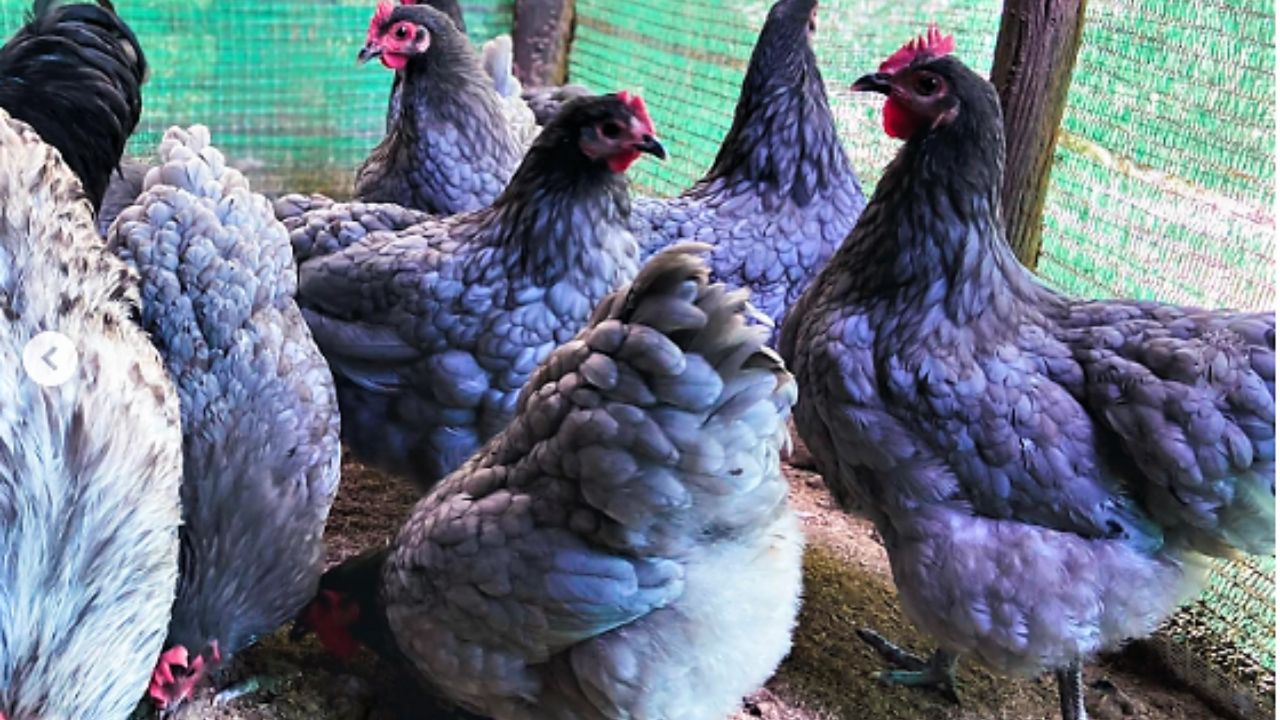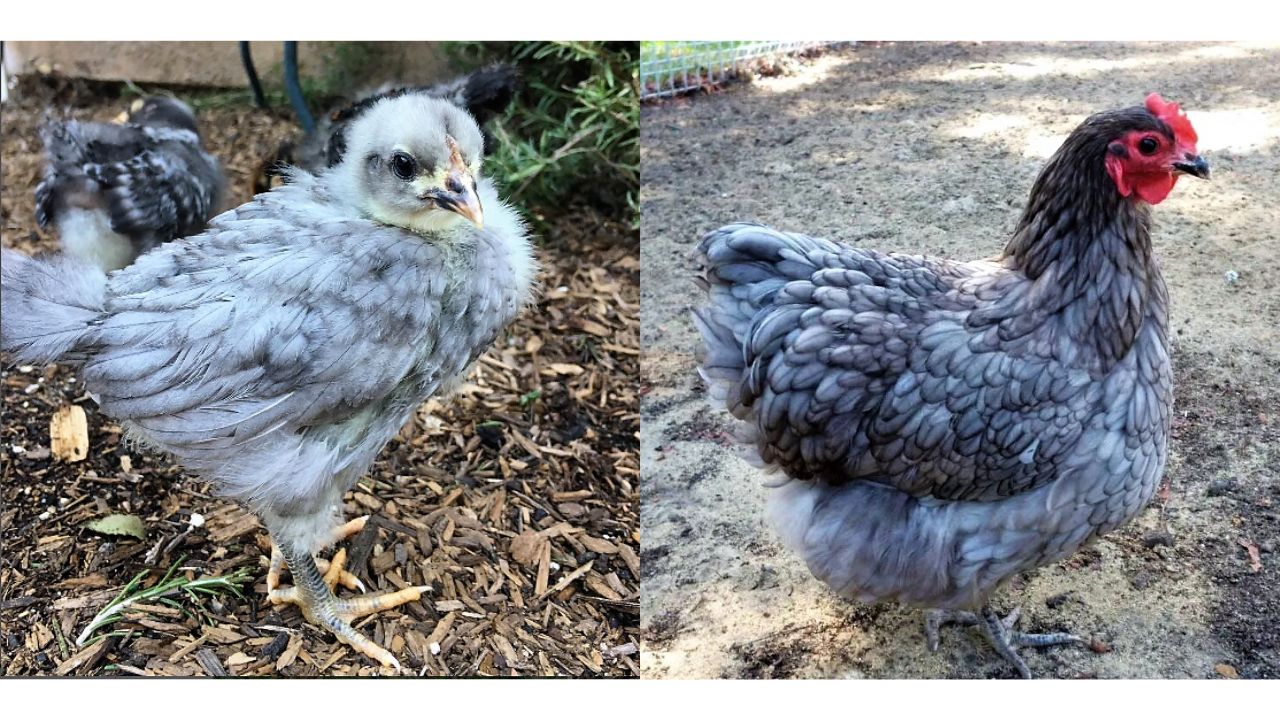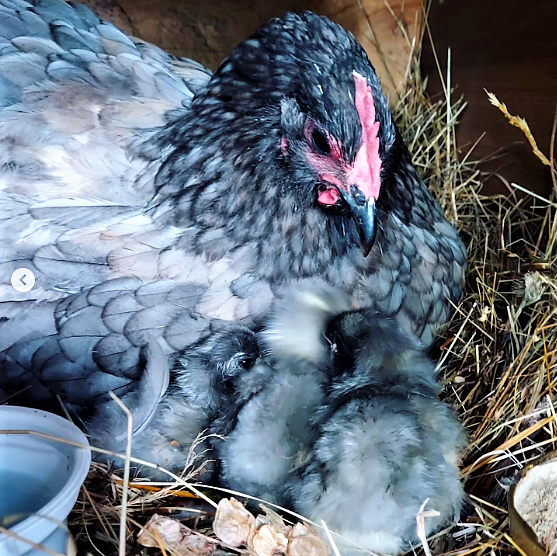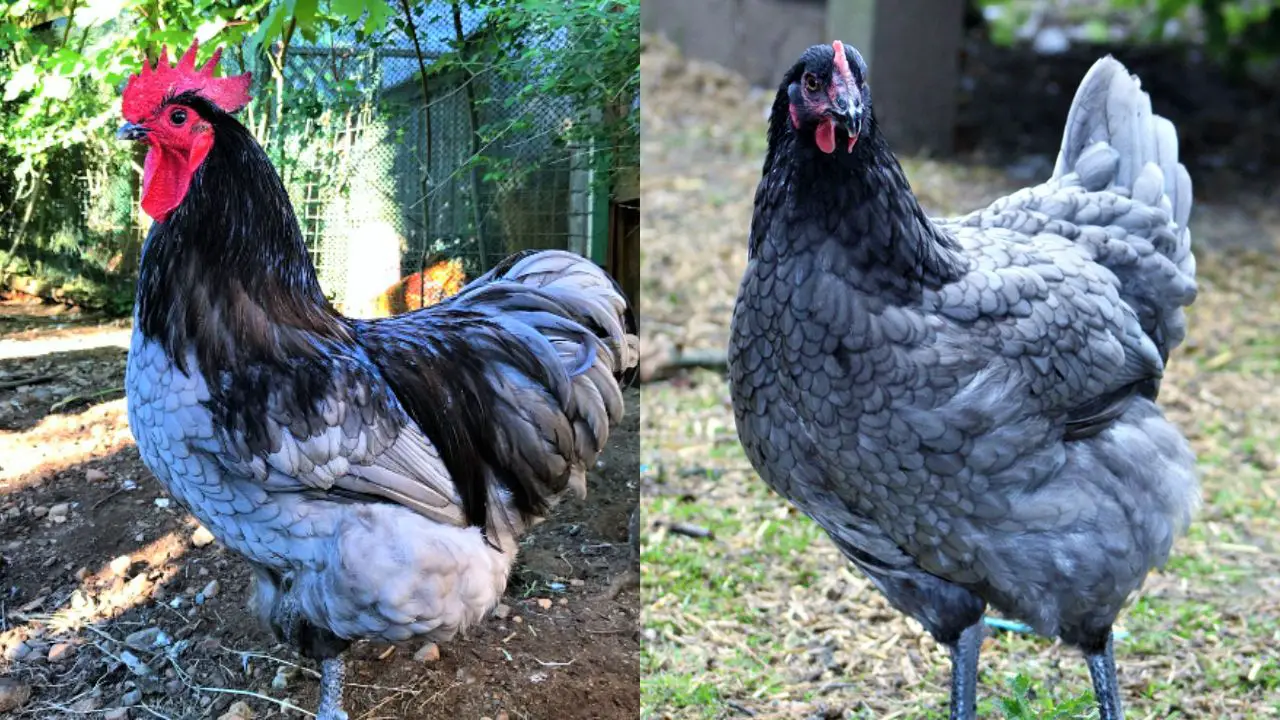Blue Australorp chickens are popular for laying 364 eggs yearly and have many bluish feathers. They are dual-purpose breeds with a docile and friendly nature, making them a perfect choice for any backyard.
If you’re curious about a breed that’s easy to love and super productive, stick with me – this guide’s got everything you need to know!
Let’s get started:
Overview
| Origin | Australia |
| Appearance | Bluish |
| Purpose | Dual-Purpose (eggs+meat) |
| Availability | Rare |
| Age of Laying | 22-28 weeks of age |
| Eggs Quantity | 250- 300+ per year (364 eggs record) |
| Egg Size | Large |
| Egg Color | Brown |
| Weight at Maturity | Rooster 8.5 lbs, Hen 6.5 lbs |
| Life Span | 6 to 10 years |
| Growth Speed | Slow |
| Temperament | Docile and Friendly |
| Comb Type | Single |
| Legs | Black and Clean |
| Heat Tolerance | Low |
| Cold Tolerance | High |
| Adaptability | Variety of Climates |
Brief History of Blue Australorp Chickens
Blue Australorp chickens originated in Australia in the early 20th century and finally arrived in America during the 1920s.
The Blue Australorp breed was selectively bred from the Australian Black Orpington, White Leghorn, Langshan, and Rhode Island Red for egg-laying abilities and meat production, hence the name ‘Australorp’, A bird called the Australian Orpington – or Australorp for short!
In 1922 and 1923, a group of six Australorp hens laid an exceptional 1,857 eggs, averaging over 309 eggs per chicken per year.
Fun fact: According to Zoosa, one Blue Australorp also has a record for laying 364 eggs in 365 days during the 1920s. Awesome!

Characteristics of Blue Australorp Chickens
Here are some fantastic qualities of blue australorp birds:
-
300+ Eggs Laying Capacity
Get ready for an egg party! Blue Australorps lay 250-300 eggs annually, 4-5 light brown eggs weekly. They start at 5 months and keep going strong.
Some are even laid through October and Jan! The brown shell sometimes has a slight pink coloring from a natural coating. Sure, they slow down during moulting in autumn, but bounce back when it warms up.
According to “Zoosa,” Blue Australorp also holds a record for laying 364 eggs in a year. To boost egg-producing capability, you must provide suitable, soft, and fine nesting boxes, a balanced diet, proper health care, and a stress-free environment.
-
Good Sitters and Mothers
Blue Australorps also go broody. They are considered good sitters and mothers, and they can sit and hatch their eggs.
For many breeds, you need to collect their eggs and use artificial methods to incubate and hatch them.
In the case of blue Australorp, you almost don’t need to incubate and hatch their eggs; they will do this by themselves.
-
Temperament and Personality
These chickens are quiet, calm, and never pushy. In the pecking order, they hang out in the middle, playing nice with other breeds. They will follow you around, curious about a treat – proof they’re intelligent and love interacting with humans.
They’re docile, friendly, and gentle with kids and want to be close to humans, making them a top pick for backyard flocks.
They don’t disturb their environment, which makes them perfect pet chickens for any family with children.
They love to forage and explore their environment for foods like green plants, insects, seeds, etc.
-
Hardiness and Adaptability
Blue Australorp are hardy, they are not prone or susceptible to many diseases.
They also adapt to different climates and environments; they easily thrive in cold weather or winter.
They also don’t need ample space to manage and keep. If you have a small space or backyard, these are the perfect choice for you.
-
Compatibility and Suitability
As Blue Australorp is calm and peaceful by nature, they are great for mixed poultry flock integration.
These chickens are a versatile addition to any backyard/flock, getting along well with other chicken breeds.
Blue Australorps are a great choice for first-time or beginner chicken owners due to their impressive hardiness, calm and gentle temperament, and prolific egg-producing abilities.
Appearance of Blue Australorp Chickens
Blue Australorps rock iridescent blue-gray feathers with lacing that shimmers like beetle green sheen. Their red comb, wattles, and earlobes pop against slate-blue legs and black beak. It’s love how their plumage glows in the sun!
These standard birds aren’t small fry. Hens weigh 6.5-8.5 lbs, while roosters hit 8.5-10 lbs.
Want something tinier? The bantam variety ranges from 1.7-2.2 lbs for females to 2-2.7 kg for males. Their rectangular-shaped body, full breast, and 45-degree angle tail give them a downright imposing upright carriage.
They are just perfect, with bluish, soft, blue-gray feathers, like the blue star, laced with black around the edges.
They have a broad, deep body and a slightly curved back. Their single comb is medium to large and serrated. Their wattles are round and medium in size.
They have broad tails at a 45-degree angle, wide-set robust legs, and feather-free four-toed feet. It’s worth noting that their heads are small but carried high, and their beaks are undeniably strong and distinctly curved.
The Lifespan of Blue Australorp Chickens
Lifespan depends on many factors like environment, diet, relationships, health, etc.
Blue Australorp is hardy and adaptable to various climates and a docile breed with a gentle nature. They often have strong attachments to their owners.
Approximately Blue Australorp can live 6-10 years, you can boost their longevity through proper health care, a balanced diet, providing a comfortable environment, etc.
How to Breed Blue Australorp
Blue Australorp is an exceptional breed prized for its blue-gray feathers, superior and prolific egg production, and hardiness and adaptability to different climates.
That’s why we all want to hatch their eggs for their next cute chicks, which gives us the benefits and joy we want.
Here is the full process of breeding Blue Australorp:
-
Care Before Mating Parents
Before mating, you need to provide a balanced diet, ample space for their activities, a clean and stress-free environment, soft and fine nesting boxes in their coop, and health care.
-
Select Healthy Pair
Selecting the true representatives of the Blue Australorp breed will ensure the outcome of real and true results.
Also, a healthy and mature pair is needed for this process to obtain genuine results.
-
Mating the Pair
To ensure successful mating, the birds must be healthy and mature and reach the proper level of maturity.
Hens should be around 6-7 months old, while roosters should be slightly older than hens.
The magic of mating happens naturally when a male and female are together in a suitable environment. It’s amazing to see how nature takes its course, isn’t it?
-
Eggs Collecting
Daily, collect the freshest laid eggs from your blue Australorp hens and ensure that they are stored safely.
Ensure that the eggs you collect and store are from mated hens, not unmated hens, because the eggs of unmated hens are not fertilized.
-
Incubating and Hatching Eggs
If you have an incubator, you can use it to incubate and hatch the eggs you stored for blue Australorp chicks.
If you do not have an incubator, don’t worry! You can easily encourage the hen to become broody and incubate the eggs herself. Trust the process, as the chicks will surely hatch within 21 days.
| How will the Blue Australorp chicks?
The mesmerizing color of blue australorp chicks results from the ‘Andalusian Blue’ genetic trait. When two Australorp parents come together, their fluffy offspring can surprise you with various colors. The chicks from two blue parents can be blue, black, or splash (primarily white with blue spots). It’s a genetic masterpiece unfolding in the coop, where each chick tells a unique and beautiful story of its heritage. |
-
Now Rearing Chicks
Broody hens are great moms – they sit on eggs for 21 days to hatch chicks! Not into broodiness? Remove the eggs to stop it.
Now you have blue Australorp chicks, so proper care for your new babies is essential. For hatching, keep chicks warm at 33 degrees in a safe spot. Watching them grow their actual feathers is pure joy!
The chicks need a warm and safe environment, proper care, and chick feed. As they grow, they will develop their blue plumage and unique characteristics.
Breeding Blue Australorps and the Outcome of Chicks: Australorps’ blue color follows the ‘Andalusian Blue’ genetic trait, meaning chicks from two blue parents can be blue, black, or splash (primarily white with blue spots).

How to Care for Blue Australorp Chickens
If you’re considering getting Blue Australorp chickens or already have some in your flock, here are some tips on how to care for them:
Housing:
Blue Australorps require a spacious and clean living environment. A coop with at least 4 square feet of space per bird is recommended. You can also use an automatic door in your chicken coop.
The coop should be well-ventilated, draft-free, and provide protection from predators. Bedding materials such as straw, pine shavings, or sand should be used to keep the coop clean and dry.
Feeding:
A well-balanced diet is essential for the health of your chickens. They require a high-quality layer feed that is high in protein (around 16%) and supplemented with calcium for strong eggshells. It’s also important to provide fresh water in a waterer at all times.
In addition to commercial feed, you can give your chickens treats such as fruits, vegetables, and mealworms in moderation.
Be sure to avoid giving them any salty or sugary foods as they can cause health issues.
Health Care:
To maintain good health in your Blue Australorps, regular health checks are important.
Look out for any signs of illness or injury, such as decreased appetite, weight loss, difficulty breathing, and abnormal droppings. If you notice any of these symptoms, consult a veterinarian immediately.
Regularly cleaning the coop, replacing bedding and flooring materials, providing a heater or lamp, and removing any standing water can help maintain a healthy environment.
Exercise:
These chickens are active birds that require space to roam and exercise.
It’s important to provide them with a spacious outdoor run or fenced-in area where they can scratch and peck at the ground.
This not only gives them room to exercise but also provides them with opportunities to forage for bugs and other natural foods.
Socialization:
As mentioned earlier, Blue Australorps are known for their friendly and docile nature.
They do well in both small and large flocks, so it’s important to provide them with social interaction.
Keeping a rooster in the flock can also help maintain a peaceful hierarchy among the birds.
Grooming:
Blue Australorps have beautiful blue feathers that require minimal grooming. However, it’s important to regularly check for any mites or lice and treat them accordingly.
A dust bath area can also be created using sand or diatomaceous earth to help keep these parasites at bay.
Final Thoughts on Blue Australorp
So, there you have it – the full scoop on Blue Australorp chickens! They’re prolific egg layers, quiet birds known for their blue-gray feathers, and the best buddies for backyard fun.
These chickens are a perfect choice for any backyard or flock owner and for families with children.
Ready to add these gorgeous Australorps to your flock? Trust me, you won’t regret it.
Drop your thoughts below – I’d love to hear from fellow chicken keepers!
FAQs Related to Blue Australorp
For what purpose does Blue Australorp chicken create?
The purpose of these chickens is to create a breed that is dual-purpose, meant for egg and meat production, but especially for egg production.
Are blue Australorps rare chickens?
Yes, they’re still considered a rare breed due to their slow rate of growth and non-availability.
Can blue Australorp fly?
Almost no, as they are heavy birds, therefore they struggle to fly.
What color eggs do Blue Australorps lay?
Blue Australorps lay brown eggs. These eggs are usually medium to large and have a nice, rich color. No blue eggs here – just brown!
What is the difference between Black Australorp and Blue Australorp?
The difference is all about their feathers. Black Australorps have shiny black feathers, while Blue Australorps have pretty blue-gray feathers. They’re the same breed, so they act the same and lay the same brown eggs.
What are the pros and cons of Australorps?
Australorps are awesome chickens! Here’s the scoop:
Pros: They’re super friendly, lay tons of eggs (250-300 a year), and can handle different weather.
Cons: They’re not great at finding their own food and sometimes sit on eggs too much (that’s called going broody).
How many eggs do Blue Australorps lay a year?
Blue Australorps lay about 250 to 300 eggs every year. How many they lay depends on their food and how happy they are at home.
What chicken lays 364 eggs a year?
An Australorp hen once laid 364 eggs in 365 days back in the 1920s, setting a world record! Most Australorps don’t lay quite that many, but it shows how amazing they can be.
What age do Australorps start laying?
Australorps start laying eggs when they’re 5 to 6 months old. That’s when they’re ready to share their brown eggs with you!
How to tell if an Australorp is male or female?
It’s easy to spot the difference! Roosters (males) have bigger combs and wattles (the floppy red bits on their head) and longer tail feathers. Hens (females) have smaller combs and wattles and shorter tails.
What do Australorps eat?
Australorps eat regular chicken food like layer pellets, grains, and veggies. They also love treats like mealworms – yummy!
How fast do Australorps grow?
Australorps grow pretty fast. They’re fully grown in about 5 to 6 months, ready to strut around the coop.
Why do Australorps stop laying eggs?
Australorps might stop laying eggs if they’re getting old, losing feathers (called molting), feeling stressed, or if their food or home changes.
Can Australorps lay pink eggs?
Australorps mostly lay brown eggs. Sometimes they might look a tiny bit pink, but true pink eggs are super rare for them.
Do Australorps lay green eggs?
Nope, Australorps don’t lay green eggs. Those come from other breeds like Easter Eggers or Olive Eggers. Australorps stick to brown!

Hello! I’m Ibrahim, the owner and writer of this blog. I run a chicken farm with 160 chickens, and I’ve gained a lot of knowledge about raising and caring for them. Now, I want to share my insights and experiences with you to help you in chicken keeping.


8 thoughts on “Blue Australorp Chickens 364 Eggs A Year”